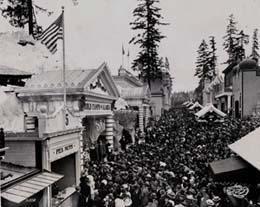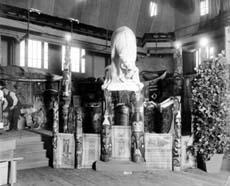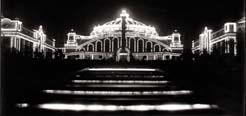

This story ran in The Seattle Times on February 18, 1996
By Sharon Boswell
and Lorraine McConaghy
Special to The Times
 Huge crowds throng the Pay Streak, a carnival-like midway
offering everything from mock Civil War battles to Chinese juggling acts.
Photo Credit: F. H. Nowell / AYPE Photographer
Huge crowds throng the Pay Streak, a carnival-like midway
offering everything from mock Civil War battles to Chinese juggling acts.
Photo Credit: F. H. Nowell / AYPE Photographer
THE GATES OF THE ALASKA-YUKON-PACIFIC EXPOSITION OPENED at 8:30 a.m.,
but early on the morning of Sept. 2, 1909, a crowd of Smiths had already gathered.
Yes, Smiths: By that evening, more than 5,000 people with America's most common
surname had celebrated Smith Family Day, with ceremonies that included a Smith parade
and awards for the tallest and shortest, fattest and thinnest, most beautiful and most
homely Smiths in attendance.
Smith Day was but one promotion in a calendar crammed with
special events. The Alaska-Yukon-Pacific Exposition was designed to showcase
Seattle as an ambitious port city, the up-and-coming commercial center of
the Pacific coast. But a huge turnout of local residents was essential to the fair's financial success.
Boosters predicted the fair would bring the city worldwide recognition,
and business to match. Yet it also -- perhaps more than its planners ever envisioned -- drew
together the citizens of Seattle, uniting them in pride, even awe, at the cultural extravaganza
they were hosting.
The Alaska-Yukon-Pacific Exposition officially opened on June 1, 1909,
on the University of Washington campus. Nearly 90,000 local residents and guests from
around the world helped celebrate Seattle's achievement.
President William Howard Taft wired his congratulations from the nation's capital,
complimenting the people of the Northwest on the exposition, "designed as it is to exploit
the natural resources and marvelous wealth of Alaska and the development of trade and
commerce on the Pacific Slope."
When the president pressed a telegraph key,
studded with gold nuggets from the Klondike, and transmitted his message
to Seattle, the crowd responded with shouts of triumph.
The exposition's local backers no doubt breathed
a sigh of relief. Nearly four years before, these civic leaders had organized
an exposition company charged with promoting and financing a huge trade fair.
They raised preliminary funds with a capital stock offering,
and Seattleites responded generously by purchasing $650,000 worth of shares in just
one day. The state agreed to contribute $1 million to the effort if most of it went
into creating permanent buildings that the university would get at the exposition's end.
The remaining money came from the federal government, potential exhibitors, local banks
and individuals.
 Inside the Alaska Building, exhibits include treasures
from coastal Indian peoples and examples of the state's natural wonders.
Inside the Alaska Building, exhibits include treasures
from coastal Indian peoples and examples of the state's natural wonders.
Photo Credit:Seattle Times
But when the completion date neared, the fair's board almost ran out of money.
Local newspapers stepped in, cajoling and shaming wealthy residents into supplying the rest.
Contrary to predictions, the fair opened on time.
Critics still argued that the price tag for the fair -- nearly $10 million --
was too expensive and that no one would attend. But attend they did. More than a million showed
up in the first month and a half.
Besides special events to attract visitors,
the exposition sold bonus passbooks allowing multiple visits at reduced rates,
and The Times published a daily schedule of events on the front page,
enticing area families to take advantage of this rare opportunity.
Frequent fairgoers had their own favorite buildings and exhibits.
Crowds often congregated in front of the imposing United States pavilion, enjoying
spectacular vistas of cascading waterfalls, fountains and Mount Rainier,
while others admired the Forestry Building with its colonnade of monumental Northwest fir.
Hundreds of cities, states and foreign countries sponsored
displays, but the most lavish highlighted the riches of the Pacific Rim -- everything
from fanciful arrangements of California produce to Asian silks and teas to realistic
depictions of gold mining in Alaska. Commercial exhibitors showed examples of the
latest technologies, while the federal government treated fairgoers to glimpses of the nation's past.
 After dark, electric lights silhouette the fair's major buildings.Photo Credit:Seattle Times
After dark, electric lights silhouette the fair's major buildings.Photo Credit:Seattle Times
BUT THE PAY STREAK WAS THE FAIR'S MOST POPULAR FEATURE,
its carnival-like midway always jammed with thrillseekers wanting a turn on the ferris wheel,
a ride in a rickshaw or a view of exotic dancers from Cairo.
Thousands even paid to stare at native peoples from the Philippines,
the Igorrotes, who lived through the entire fair in a replica of one of their villages.
In the 138 days that the exposition lasted,
Taft visited along with many foreign dignitaries and heads of state,
but most of the 3.7 million who came through the gates were Northwest families
just like the Smiths. The Alaska-Yukon-Pacific Exposition introduced
Seattle to the world as a first-class commercial city but also introduced
a world of wonders to eager local residents.
Historians Sharon Boswell and Lorraine McConaghy teach
at local universities and do research, writing and oral history.
Original newspaper graphics courtesy of the Seattle Public Library.
More photos
Table Topics



Copyright © 1996 The Seattle Times Company
 Huge crowds throng the Pay Streak, a carnival-like midway
offering everything from mock Civil War battles to Chinese juggling acts.
Photo Credit: F. H. Nowell / AYPE Photographer
Huge crowds throng the Pay Streak, a carnival-like midway
offering everything from mock Civil War battles to Chinese juggling acts.
Photo Credit: F. H. Nowell / AYPE Photographer Inside the Alaska Building, exhibits include treasures
from coastal Indian peoples and examples of the state's natural wonders.
Inside the Alaska Building, exhibits include treasures
from coastal Indian peoples and examples of the state's natural wonders.
 After dark, electric lights silhouette the fair's major buildings.Photo Credit:Seattle Times
After dark, electric lights silhouette the fair's major buildings.Photo Credit:Seattle Times